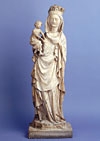Flawford St PeterFeatures and Fittings
The Alabasters

The Virgin and Child
Image © Nottingham
City Museums and Galleries |
During the 14th century Nottingham was the home of the alabaster industry. Three figures, known as the Flawford Alabasters, were carved around the end of the 14th century. Cheetham dates them to c1400. They have flat backs, ie they were designed to stand against a wall, possibly in a wooden housing.
When discovered in 1779 by workmen taking up the chancel floor they still retained much of their original rich colouring. Subsequently, however, they were used as garden ornaments and overpainted in a stone colour. The paint was inexpertly removed, resulting in only slight traces of the original colours.
The alabaster is presumed to be local, and almost certainly the figures were carved in Nottingham, all during the same period, and possibly by the same sculptor.
1 The Virgin and Child The Virgin and Child
The figure is of the Virgin Mary, smiling serenely, 32 ins. high excluding the base, she is clothed in a long gown, a loose over-dress, a crimped-edge veil which she holds with her left hand, pointed shoes, and she wears a crown. She holds the Infant Jesus on her right arm; he is clothed in a long loose robe, and is touching his Mother’s exposed right breast (commonly depicted in medieval times). Traces remain of gold and blue on the crown, gold on Mary’s hair and red on her gown, and gold on the hem of the Child’s robe.
2 An unknown Bishop An unknown Bishop
The figure is of an unknown person, possibly representing St Wilfrid of York, and is 37.5 ins. high excluding the base. He wears a mitre and Mass vestments, originally coloured red, and holds a crozier in his left hand. His gloved right hand, with a ring over the glove, is raised in blessing.
3 St Peter as Pope St Peter as Pope
The figure is about 32.5 ins. high excluding the base, and is wearing Mass vestments and a mitre and the triple tiara. His gloved right hand is raised in blessing, and over his right arm is a pair of keys, a common symbol for St Peter in the Middle Ages. In his left hand he holds a church, symbol of his position as head and pastor of the church. On his right side is a figure, damaged, kneeling on two cushions and holding a long scroll. There are traces of gold on his vestments, keys and the church model, mitre and kneeling figure’s gown; and red colouring on the ears and folds of sleeves.
Other Fittings
Around 1916 an ancient font was dug out of a field in Bunny Moors, having been used as a drinking trough for cattle – this was said to be from the 11th century Bradmore church which was burned down in 1705, and which was a separate parish from Bunny until 1770. It is possible it was the font from Flawford church.
| 










